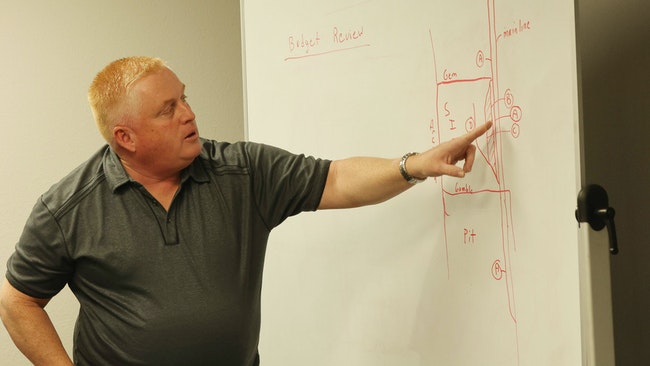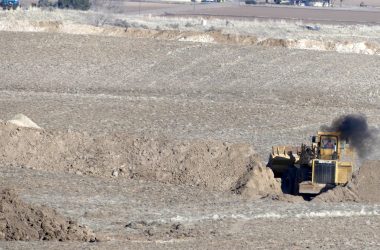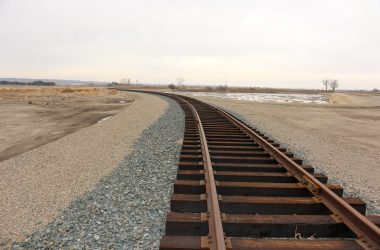NYSSA – Costs for the Treasure Valley Reload Center ballooned yet again since last Friday, putting Malheur County officials on the hunt to find nearly $10 million in the next 60 days.
There is no assurance they will get it and the lead engineer warned Tuesday that failure to plug the budget gap could mean putting on hold for now the centerpiece of the project – the warehouse building itself.
The bad news rolled out during a meeting in Nyssa on Tuesday of the Malheur County Development Corp. This is the public company set up by Malheur County commissioners to manage the project and get the rail shipping center up and running.
Just last week, Malheur County officials disclosed they calculated the project was $5 million over budget, itself a surprising figure.
But the implications of nearly doubling that shortfall are significant.
Greg Smith, Malheur County economic development director, said the project may need to borrow millions from the state. Such a move could saddle Malheur County and its taxpayers with even more debt to build a public complex whose purpose is to cut costs for the area’s onion growers and shippers.
Any more delay could threaten the ambition of having onions from this year’s harvest shipped by rail from Nyssa. Without that rail service, the Treasure Valley’s onion industry will have to continue to rely on trucking. There is a national shortage of trucks and costs to employ them are soaring.
At Tuesday’s meeting, board members listened mostly in silence as they were briefed on the worsening financial situation for the public works project. That included Grant Kitamura of Baker & Murkami Produce Co. in Ontario, Kay Riley of Snake River Produce in Nyssa, Corey Maag of Jamieson Produce in Vale, and Jason Pearson of Eagle Eye Produce in Nyssa.
The only actions the four directors took on Tuesday were to approve minutes and a change in a construction contract and to authorize a utility company to work on the project.
They took no action addressing the financial crisis and gave no indication on how they would deal with it. Kitamura subsequently cut off press questioning, allowing no more than five minutes despite time set on the board’s agenda for that purpose.
The meeting, the first one held in person in years, drew several observers, including Malheur County Judge Dan Joyce, County Commissioner Ron Jacobs, County Counsel Stephanie Williams, Nyssa Mayor Betty Holcomb, Nyssa City Manager Jim Maret, Undersheriff Travis Johnson and Bill Johnson, a director on the Eastern Oregon Border Economic Development Board.
Smith participated via videolink from an undisclosed location, and opened the meeting putting a rosy spin on matters. He started with the history of the Oregon Lottery, recounted deals struck with Union Pacific Railroad and with Americold, the company contracted to run the shipping center, and complained of the “significant side task” of responding to public records requests.
In his opening remarks, Smith, who has been in charge of the project since the beginning, gave no clue the project faced its gravest financial crisis since legislators approved the initial funding five years ago.
He left that task to Brad Baird, lead engineer on the project and president of Anderson Perry & Associates of La Grande.
Baird laid the groundwork for his stunning disclosure by recounting troubles encountered at the work site, farmland north of Nyssa.
He told of finding unexpected amounts of groundwater on the site, requiring a “ridiculous” amount of fill material that will add an estimated $5 million to the project.
He described how construction crews kept discovering “wet spots” and then hitting yet another surprise – a buried pit of onions that was 5 to 6 feet deep and 300 feet long. He described how heavy equipment sunk in when it hit the spot.
Baird told how contractors had to dig down not the expected 5 feet or so but, in some places, had to clear material to a depth of 12 feet to get to solid ground. Such a hole is equivalent to the height of a one-story house.
He told of work that had to be “re-done” when testing showed what had been accomplished wouldn’t meet requirements to support train traffic.
Baird then disclosed that a bid opened the previous Thursday to build the 60,000-square foot rail building produced another surprise.
Just a day before bids were due, Smith reported to state officials that “multiple serious companies” were “interested” in the work.
But on Thursday, only one Idaho company bid – and its price was $2.9 million higher than expected, Baird said.
He was clearly surprised by the number.
“It makes no sense,” he told the board.
He said the project team would try negotiating with the bidder to bring down the price, but that could delay the work. The contract was scheduled to be awarded on Thursday, April 14, with construction starting next month. Responding later to a media question, Baird insisted there would still be time to get the building completed by the end of September, just ahead of the peak onion shipping season.
But putting up the building will require finding more money, Baird said.
He presented a revised cost estimate that showed the project is now short $9.8 million. “Obviously, we need to find it before we need it,” Baird said, confirming in later remarks that the extra money would be needed in 60 days. He said it was a “worst case” scenario but the financial news has gotten worse month by month, rendering obsolete one estimate after another.
Baird noted that the $26 million awarded by the state in 2017 anticipated the rail center would be built in 2020. He said inflation since then has driven up costs, but he didn’t explain whether he and Smith have adjusted their budgets in the past year to reflect that.
Smith did manage to obtain an extra $3 million from the Oregon Legislature last year to cover the cost of a critical water line that had been dropped from plans.
Smith had assured state officials more than a year ago, though, that the project could be built for the original $26 million.
Now, if added costs are included, the Treasure Valley Reload Center could end up costing the public $35.8 million – far higher than what Smith represented in January 2021.
Where to get that money was left to Smith to explain, but he offered few details.
Smith said the project could turn to a state special works fund for the money.
But only under later questioning did Smith concede that money would be from a loan that would have to be repaid. He couldn’t clearly explain how he would arrange for that to happen.
He also implied there had been a “miscommunication” when he reported to the board last month that the Legislature had recently given the project another $3 million helping of public money. There was no such allocation.
Smith said elected officials now were in touch with leaders in the Oregon House and Oregon Senate about the need for more money.
State Sen. Lynn Findley, R-Vale, holds a seat on the development company board but didn’t attend Tuesday’s session.
He said in an email to the Enterprise Tuesday afternoon that he and state Rep. Mark Owens, R-Crane, had recently requested $2.8 million from the state Emergency Board for the project. He said the figure represented “my understanding of the short fall…I have not spoken to Greg in several days.”
Smith said there were two other possible sources of money – the regional border board and the state Transportation Department. He noted the border board recently was given another $6 million by the legislature for economic development work in Malheur County. Board officials over the weekend said they had had no contact from Smith about the matter.
Smith also said project leaders could ask the Transportation Department to put in the extra money. The agency is charged by the Legislature to oversee the original $26 million to see that it is spent appropriately.
Smith said cutting some project features may be necessary, such as eliminating some of the access roads to the Nyssa project and convincing Americold to drop its insistence for cooling equipment for the building.
“We’re going to spend what we have and we have to trim what we can’t afford,” Smith said.
Baird was more blunt about what could be ahead. He said the money on hand would allow rail lines to be installed, ready for train traffic. But they may lead to empty ground for a time.
“The building wouldn’t be built….if we aren’t able to find additional money,” Baird said.
Joyce, the Malheur County judge, said in a later interview that “I’m not surprised” by the cost overruns and that “you never know where it’s going to go.”
As for where the money needed will come from, Joyce said, “I don’t have a clue.”

Greg Smith, Malheur County economic development director, participates remotely in a Malheur County Development Corp. board meeting on Tuesday, April 12, where his team disclosed new financial troubles for the rail project. (ANGIE SILLONIS/Special to the Enterprise)
Contact Editor Les Zaitz: [email protected]
PREVIOUS COVERAGE:
Nyssa rail project short up to $5 million as work falls behind schedule
Smith touts new, $3 million infusion of cash from Legislature for rail center, but it’s not there
Cost for rail for Treasure Valley Reload Center comes in high; one key track line remains optional
‘NEED $3.6 MILLION’ – Records raise questions about Malheur County rail center finances
EXCELLENCE IN JOURNALISM – Available for $5 a month. Subscribe to the digital service of the Enterprise and get the very best in local journalism. We report with care, attention to accuracy, and an unwavering devotion to fairness. Get the kind of news you’ve been looking for – day in and day out from the Enterprise.




